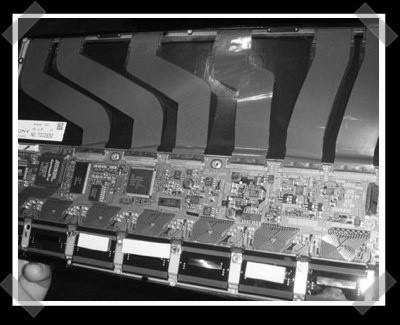
[bunnie] just happened to be at the Embedded Systems Conference in San Jose on exactly the right day to witness the live teardown of a Sony XEL-1 OLED TV. The XEL-1 is Sony’s flagship OLED panel that’s only 3mm thick… and $2500 for just an 11-inch screen. [bunnie] was able to take quite a few shots of the components as they were passed around. He pointed out a few interesting bits about the construction. There seems to be quite a bit of thermal material on the display to prevent “avalanche thermal failures” (which I’m guessing doesn’t look as cool as it sounds). OLED displays are completely transparent and their legendary contrast ratio is just a result of the dark backing material. The mainboard seems to be a bit of overkill for this TV and [bunnie] concludes that it’s just the standard image engine architecture from Sony’s Bravia line put into a smaller package.
13 thoughts on “Sony XEL-1 OLED Teardown”
Leave a Reply
Please be kind and respectful to help make the comments section excellent. (Comment Policy)















OLED’s are quite sexy. Just really expensive now. LCD panels finally got into the sane range of price; can we expect oled’s to fall thusly in the coming decade? I hope they solve the short lifespan problems soon, too.
“avalanche thermal failures” in the circle of led products I do believe refers to when you have parallel strings of LEDs, one dies – causing more current to go to the rest, thus increasing the likelihood that they will fail – similarly, hot LED’s have less resistance, so they conduct more current, and get hotter – avalanche.
http://en.wikipedia.org/wiki/Avalanche_breakdown
lol i just bought embedded ce and xp to experiment with a few arm controllers and a few intel xscales i was looking in to oleds but i am reconsidering i dont like the drivers and i dont like the detonation (im looking 4 small screens but with a high definition)
Isn’t bunnie female?
no, bunnie’s male.
Can anyone say linux built into a TV?
My Sharp aquos 1080p LCD tv uses embedded linux.
bwahaha.. “avalanche thermal failure” indeed… yeah, thats what i had once when testing an OLED panel from a broken phone. It looked fine, then got brighter and brighter and then rapidly darkened and went out in spots followed by the rest of the display :( grrr.
Interesting failure mode, shame I didn’t video it.
-A
LG tv’s also use a form of linux, I beleive the information on it is in the back of the manual, but I cant remember where mine is. As for the usb port, you can generally use that to show pictures and play music on most tv’s. If sony follows suit with a form of linux, I think a patch loaded from the usb port could be used to unlock the web browsing, and possibly support a usb keyboard to make browsing pratical, becuase the on-screen keyboard is the deal breaker for me, i hate that on xbox.
OLEDS are certainly cool, but I really took issue with the “look how thin it is!!” marketing BS in my Audio/Video mag. Yeah, thin, unless you look at the HUGE base station underneath it. So, if it were oriented on the back of the panel, how exactly would it be thinner than an LCD?
Not debating the superiority of the quality and contract, though. OLED is definitely the future. But more work needs to be done on creating thinner circuits for the drivers.
If SONY just left off the *shell game* of “Look at how thin it is!” from their promo hype (hence inflated price driven purely by marketing) the world would be a slightly better place. It is an insulting marketing ploy. How thin would LCDs be if you moved all of it’s electronics to a huge base station? My laptop screen is pretty darn thin, too.
I predict the XEL-1 will flop because most people just aren’t that stupid. Hopefully OLED TV technology survives it, though.
I was there when they did this breakdown. It really was boring, and bunnies photos are much more interesting than being there. They used a $20 webcam and a $2 light to display the breakdown to the crowd — you couldn’t see anything.
I’m just wondering – is bunny the guy with the long pony tail that was hogging the display as it was being passed around?
Should have run the panel afterwards, a transparent OLED is waaaaaaay cooler than a normal one.
Extra bonus points if someone put a conventional E-ink screen behind it so it can be put in reflective or high contrast mode.